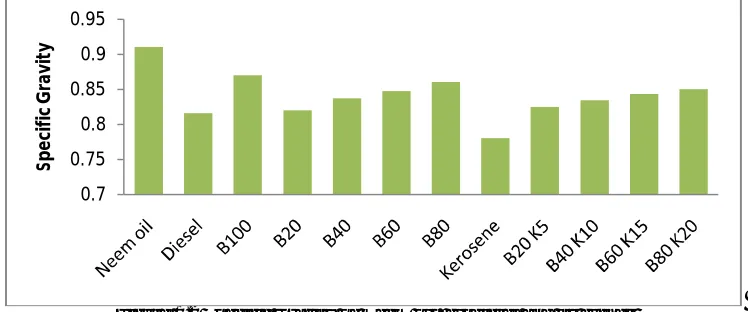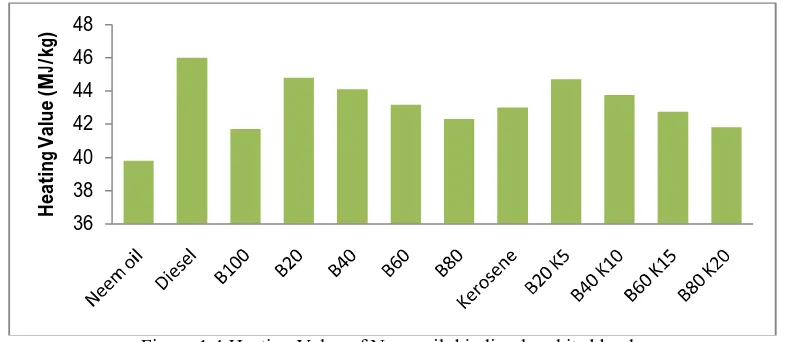Investigation of Fuel Properties of Neem Oil
Methyl Ester and Their Blends with Diesel
and Kerosene
Appese .S.D1, B.R.Hosamani2, Sreenivasan .A3
Assistant Professor, Dept. of Mech. Engineering, SKIT, Chikkabanavara, Hesaraghatta main road Bengaluru, India1
Professor, Dept. of Automobile Engg, BLDEA’s VP Dr PGH College of Engineering and Technology,
Vijayapur, India2
Professor & HOD, Dept of Mech. Engineering, SKIT, Chikkabanavara, Hesaraghatta main road Bengaluru, India3
ABSTRACT: In this paper fuel property such as viscosity, specific gravity, calorific value, flash point of Neem oil Bio-diesel and its blends with diesel oil in the ratio of 20:80(B20), 40:60(B40), and 60:40(B60), 80:20(B80) respectively were studied. It was also found that the properties of blend of B20 were very close to diesel oil. In addition to this an attempt has also made to study the fuel properties of Neem oil methyl ester blends with domestic kerosene oil and diesel oil in the ratio of 20:75:5(B20K5), 40:50:10(B40K10), 60:25:15(B60K15), and 80:0:20(B80K20),(Methyl ester : Conventional diesel : Kerosene).
KEYWORDS: Neem oil, Neem oil methyl ester, Diesel oil, Kerosene, Transesterification
I. INTRODUCTION
Presently the crude oil prices have been increasing rapidly which increases the load on foreign exchange reserves of oil importing countries like India. Research are going on all over world to find alternative automotive fuel due to increase in demand for fuel products, global warming due to emission of hazardous gases, depletion of air quality and fast degradation of supply of fossil fuel[1]. Biodiesel is one of the option as an alternative transport fuel which has received attention all over the world as an alternative auto fuel because they are renewable and eco-friendly[2,3,4] in nature and referred as green energy source. Many research work has been done in past to study the properties of methyl esters. It was noted that properties of methyl ester are closer to diesel oil [5] and deviates more with the increase in the percentage of biodiesel in the blends why because methyl ester contains nearly 10% lower calorific value than diesel oil [6]. Viscosity is an important property of fuel and it affects the flow behaviour at various temperatures. In general, viscosity increases with the increase in un-saturation. It was reported that the fuel properties of vegetable oils [7] [8] [9] as listed in table no 1 shows the viscosity of vegetable oil varies from 18.2cSt to 66.2cSt at 380C. The high viscosity of these oils is due to their high molecular weight in the range of 600 to 900, which is about 20 times that of diesel oil.
Table 1: Properties of Vegetable Oils
Vegetable oil Viscosity at
380C(mm2/s)
Heating value (MJ/kg)
Flash point (0C)
Density (kg/l)
Palm 39.6 - 267 0.9180
Peanut 39.6 39.8 271 0.9026
Pongamia 27.8 34.0 205 0.9130
Jatropha oil 18.2 38.5 174 0.9200
Rapeseed 37.0 39.7 246 0.9115
Soybean 32.6 39.6 254 0.9138
II.MATERIALANDMETHODS
Neem oil biodiesel was prepared by using two-stage transesterification process due to their free fatty acids (FFA) level is more than 1%. In the first phase, esterification reaction was carried out to minimize the FFA level. Minimum FFA was receiving by adding up 15ml methanol and 1ml H2SO4 to 100ml of Neem oil. This reaction was carried at
temperature range between 550C to 600C with a reaction time is about 60 minutes using magnetic stirrer. In the second phase, maximum yield was obtain by adding 35ml methanol and 0.3% NaOH to the sample 100ml obtained from the first stage which has lowest FFA level. During this process the temperature range of 550Cto 600C was maintained for reaction timing is 90 minutes.
Neem oil methyl ester-diesel oil blends were prepared by mixing 20% (B20), 40% (B40), 60% (B60) and 80% (B80) respectively Bio-diesel with diesel on volume basis. In addition another four blends were prepared by replacing diesel amount by 5% (B20K5), 10% (B40K10), 15% (B60K15) and 20% (B80K20) respectively in B20, B40, B60 and B80 with domestic kerosene on volume basis. The relative density of all test samples was found as per Bureau of Indian Standards (IS: 1448, P: 32: 1992).
2.1: Properties of Neem oil methyl ester and its blends with diesel oil and kerosene
Table 2: shows characteristic fuel properties such as Density, specific gravity, viscosity, flash point of diesel oil, Neem oil, Neem Bio-diesel and its blends with diesel and kerosene in different proportions. Table 2: indicates that the fuel properties of Neem oil are larger than Neem oil methyl ester and diesel oil.
Table 2: characteristic of fuel properties of Neem oil, Neem oil methyl ester, Diesel oil and Kerosene oil Fuel
property
Diesel Neem oil
B100 B80 B60 B40 B20 Kero sene
B20 K5
B40 K10
B60 K15
B80 K20
Density (kg/m3)
816 910 870 860 848.5 837.6 827 780 825 833.9 843 852
Specific Gravity
0.816 0.91 0.87 0.86 0.847 0.837 0.82 0.78 0.825 0.834 0.843 0.85
Viscosity at 400C (cSt)
4.3 40.7 4.5 4.46 4.43 4.41 4.35 1.12 4.181 4.05 3.943 3.83
Flash point 0C
53 250 175 150 126 102 77.5 52 77.3 101 126 150
Heating value (MJ/kg)
46 39.8 41.7 42.3 43.17 44.10 44.8 43 44.7 43.74 42.75 41.8
III. RESULTS AND DISCUSSION
3.1: Effect of viscosity
Figure 1.1 Viscosities of Neem oil, biodiesel and its blends
3.2 Effect of specific gravity
Figure 1.2 shows that the specific gravity of Neem oil, diesel oil and B20, B40, B60, B80 and B100, B20K5, B40K10, B60K15 and B80K20.Neem oil has more specific gravity 0.910 which is condensed to 0.860 after transesterification. S G of B20 is very close to the diesel oil which is 1.032 times higher than diesel oil. B100 has s g of 0.870 which is 1.066 times more than that of diesel oil. Figure 1.2 indicates that specific gravity increases with the increase in % of biodiesel blend.
Figure 1.2 Specific Gravity of Neem oil, biodiesel and its blends
From figure above it is clear that biodiesel, diesel oil and kerosene blends have lower specific gravity than biodiesel and diesel blends. B20K5 has specific gravity of 0.825 it is very close to diesel oil 0.816. Specific gravity of biodiesel, diesel oil and kerosene blends increases with increase in % of kerosene and corresponding decrease in diesel oil in the given % of biodiesel.
3.3 Flash point
Table 2 shows that the flash point of Neem oil, diesel oil, biodiesel, kerosene. Flash point of B20 is 77.5 0C is 1.46times more than the diesel oil. Figure 1.3 shows the flash point increases with the increase in % of biodiesel in the blend.
0 5 10 15 20 25 30 35 40 45
V
is
co
si
ty
(c
St
)
0.7 0.75 0.8 0.85 0.9 0.95
Sp
e
ci
fi
c
G
ra
vi
Figure 1.3 Flash points of Neem oil, biodiesel, and its blends
From above figure it is clear that biodiesel, diesel oil, and kerosene blends have slightly lower flash point than biodiesel and diesel oil blends. B20K5 has flash point of 77.3 0C which is more than diesel oil 53 0C. Flash point of methyl ester, diesel oil and kerosene blends increases with increase in % of kerosene and corresponding decrease in % of diesel oil in the given % of biodiesel.
3.4 Effect of heating value
Figure 1.4 indicates Neem oil has heating value of 39.82 MJ/kg which is 12.86% lower compared to diesel. The Neem biodiesel (B100) has the calorific value of 41.5 MJ/kg which is 9.2 % lesser compared to diesel. The B20 blend has the heating value of 44.86MJ/kg which is 1.83% lower compared to diesel. The lower heating value may be attributed to the presence of oxygen atoms in the biodiesel fuel. The lower heating value of biodiesel in the blends gives the way for lower thermal efficiency compared to diesel.
Figure 1.4 Heating Value of Neem oil, biodiesel and its blends
From figure it is clear that biodiesel, diesel oil and kerosene blends have lower heating value than biodiesel and diesel oil blends. B20K5 has heating value of 44.72 MJ/kg which is lower than diesel oil 45.7 MJ/kg. Heating value of biodiesel, diesel oil and kerosene blends decreases with the increase in % of kerosene and corresponding decrease in diesel oil in the given % of biodiesel.
0 50 100 150 200 250 300
Fl
a
sh
P
o
in
t
(
0C
)
36 38 40 42 44 46 48
H
e
at
in
g
V
a
lu
e
(
M
J/
kg
Viscosity of Neem oil is more than all other samples which is 9.056 times more than B100 (4.5 cSt). The lowest viscosity is considered better for engine performance in internal combustion engine. The density, flash and fire points of neem methyl ester gave good results but calorific value was slightly less as compared to diesel.
REFERENCES
[1] V.R.Kattimani, R.T.Radhika, B.M.Venkatesh, S.Ananda, IJERGS Volume 3, Issuse 1, January- February, 2005.
[2] M.C.Math, Sudheer Prem Kumar, Soma V. Chetty, Technologies for biodiesel production from used cooking oil- A review, Energy for sustainable Development 14 (2010) 339-345.
[3] Murugesan, A., Umarani, C., Subranmanina, R., and Neduchezhian, N., “Bio-diesel as an alternative fuel for diesel engine-a review”, Renewable and Sustainable Energy Reviews, 13, pp653-62, 2009.
[4] Chang, D.Y.Z., and Van Gerpen, J.H., “Fuel properties and engine performance for biodiesel prepared from modified feedstock’s”, Society for Automotive Engineering, Paper No.971684, Warren dale, PA, 1997.
[5] Schwab, A.W., Bagby, M.O., and Freedman, B., “Preparation and properties of diesel oil from vegetable oils”, Fuel, 66(10), pp 1372-1378, 1987.
[6] Chang, D.Y.Z., and Van Gerpen, J.H., “Fuel properties and engine performance for biodiesel prepared from modified feedstock’s”, Society for Automotive Engineering, Paper No.971684, Warren dale, PA, 1997.
[7] R.K Singh, K.P Saroj, Characterization of jatropha oil for the preparation of biodiesel Natural product Radiance, Vol.8 (2), (2009), pp 127-132. [8] A.S.Ramdhas, S Jayarj, C Muraleedharan, Biodiesel production from high FFA rubber seed oil, Fuel 84 (2005) 335-340.



